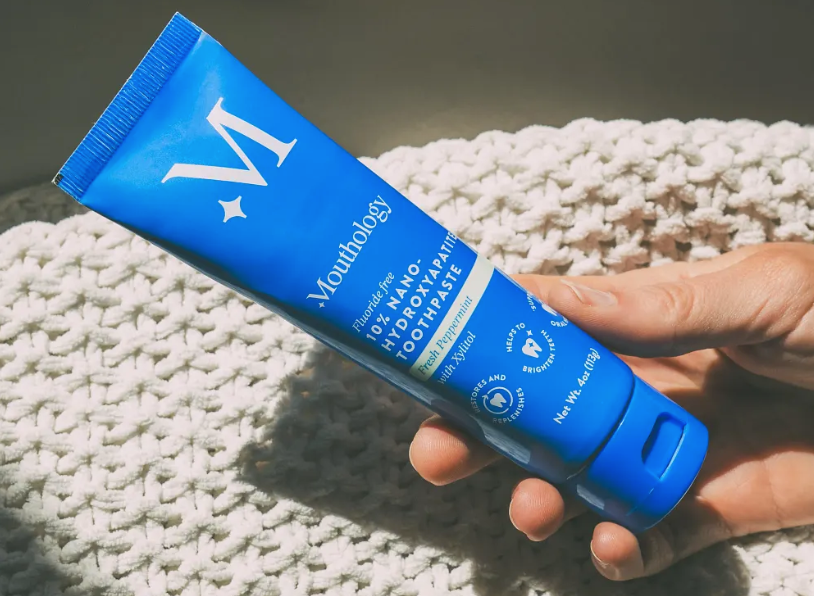Originating in India a thousand years ago, oil pulling is a natural remedy by swishing oil in your mouth for a period of time to improve oral health and overall well-being. It has now gained popularity in the Western world as an alternative practice for maintaining good dental hygiene.
Curious to learn more about oil pulling? Read this guide to discover its history, benefits, how to do it, and more!
What is Oil Pulling?
Oil pulling is an ancient practice deeply rooted in Ayurvedic medicine, reputed for its ability to enhance oral hygiene and extract toxins from the body over millennia. This method involves the swishing of oil, often coconut oil, in the mouth for a set duration to harness the oil's "pulling" action to eliminate bacteria and detritus. Coconut oil is particularly favored for oil pulling due to its substantial lauric acid content, conferring antimicrobial properties that are beneficial in this context.
Research, such as that from The National Institutes of Health (NIH), indicates that oil pulling with coconut oil can significantly lower levels of harmful oral bacteria, paralleling results achieved with traditional mouthwashes. Further, studies suggest oil pulling's potential in mitigating gingivitis, plaque, and halitosis.
However, while there is empirical backing for oil pulling's dental health benefits, broader health claims—particularly those suggesting systemic disease cures—warrant skepticism, underscoring that oil pulling is not a substitute for medical intervention.
Despite the paucity of wide-ranging studies on its full spectrum of health claims, oil pulling is becoming increasingly popular in Western practices for its scientifically supported dental health advantages, simplicity, and natural approach.
Noteworthy findings, such as those from a study published on PubMed, reveal oil pulling's efficacy in reducing Streptococcus mutans levels, a primary culprit in tooth decay, thereby affirming its role in promoting oral health.
Nevertheless, it's imperative to view oil pulling as a complementary practice to standard oral care routines rather than a solitary remedy.
History of Oil Pulling
The history of oil pulling can be traced back to over 3000 years ago, with its origins deeply embedded in the traditional Indian system of medicine known as Ayurveda.
This ancient practice involves swishing oil around in your mouth for a period, typically ranging from a few minutes up to 20 minutes, as a method to purify the body and improve oral health. Traditionally, sesame oil was predominantly used, but with modern adaptations, coconut oil has become a favorite due to its antibacterial properties.
Researchers have found that oil pulling is effective in reducing the levels of harmful bacteria in the mouth, notably Streptococcus mutans, which is often associated with tooth decay and gum disease.
There is also evidence that oil pulling can significantly reduce plaque formation and combat bad breath, which supports the historical claims of its health benefits. The technique involves swishing a tablespoon of oil around your mouth on an empty stomach, allowing the oil to "pull" bacteria and toxins from the oral cavity.
For those looking to try oil pulling, it is advised to start with a shorter duration and gradually increase as you become accustomed to the practice. Despite its ancient roots, the principle behind oil pulling remains relevant, as more individuals seek holistic and natural alternatives for their health care.
The foundation of oil pulling's effectiveness lies in its simplicity and the natural properties of the oil used, making it a compelling addition to regular oral hygiene practices for those inclined towards natural health solutions.
Benefits of Oil Pulling

Reduce Harmful Bacteria
The primary benefit of oil pulling, particularly with coconut oil, is its ability to significantly reduce harmful bacteria in the mouth. Studies highlight its efficacy in lowering the levels of Streptococcus mutans, the main bacteria associated with plaque formation and tooth decay. By incorporating oil pulling into a daily oral hygiene routine, individuals can enhance their oral health, complementing traditional brushing and flossing practices.
Help Reduce Bad Breath
Bad breath, or halitosis, often stems from bacteria and leftover food particles in the teeth and mouth. Oil pulling works as a natural cleanser, removing these elements and promoting fresh breath. This practice can be particularly effective when combined with regular dental hygiene routines, including brushing and the use of floss and mouthwash.
Prevent Cavities
Regular oil pulling has been shown to help prevent cavities by reducing plaque buildup, a key factor in cavity formation. The antimicrobial properties of coconut oil can fight against cavity-causing bacteria, supporting good oral health alongside traditional cavity prevention methods like brushing with fluoride toothpaste and reducing sugar intake.
Reduce Inflammation and Improve Gum Health
Gingivitis, an early stage of gum disease, is marked by inflammation of the gums. Oil pulling can help reduce this inflammation by removing bacteria that contribute to gum disease. Its antibacterial properties can improve gum health, helping to prevent more severe gum diseases that can lead to tooth loss if left untreated.
Cheap and Easy to Do
One of the most appealing aspects of oil pulling is its simplicity and low cost. Unlike expensive dental treatments, coconut oil is affordable and readily available. The practice requires only a tablespoon of oil and a few minutes of your time, making it an easy addition to your daily oral hygiene routine.
Can White Your Teeth
Oil pulling may promote whiter teeth by removing stains and plaque build-up on the surface of the teeth. Coconut oil in particular can whiten your teeth due to its lauric acid content, which can help break down plaque and remove surface stains. However, it's important to note that oil pulling should not be considered a substitute for professional teeth whitening treatments.
Other Health Benefits
While the primary focus of oil pulling is oral health, some proponents claim it offers additional benefits, such as detoxifying the body, although more research is needed in these areas. However, improving dental hygiene through practices like oil pulling can have a positive impact on overall health by reducing the risk of bacteria-related conditions in the body.
The benefits of oil pulling with coconut oil are multifold, promoting oral health by reducing harmful bacteria, preventing cavities, and improving gum health. This practice is a complementary addition to standard dental care routines, including brushing, flossing, and the use of chlorhexidine mouthwashes, in the fight against plaque, cavity formation, gingivitis, and other oral health issues.
How To Do Oil Pulling?
As mentioned, oil pulling involves swishing oil around in your mouth for a duration, preferably before brushing and on an empty stomach. The steps below outline the basic process of oil pulling:
Step 1: Choose Your Oil
Begin by selecting the oil you wish to use for oil pulling. While coconut oil is highly recommended due to its antimicrobial properties and pleasant taste, sesame or sunflower oil are also traditional choices. Ensure the oil is of high quality and preferably organic, to maximize the health benefits.
Step 2: Start with a Small Amount
Especially if you're new to oil pulling, start with a smaller amount of oil—about a teaspoon is sufficient. This makes the process more manageable as you get used to the sensation and consistency of swishing oil in your mouth. You can gradually increase to a tablespoon as you become more comfortable with the practice.
Step 3: Swish for 20 Minutes
Gently swish the oil around your mouth, pulling it through your teeth and ensuring it reaches all parts of your oral cavity. Aim for a duration of 20 minutes to maximize effectiveness. It's important to keep the motion gentle to avoid jaw fatigue. Remember, the goal is to "pull" bacteria and toxins from your gums and teeth, not to forcefully scrub them away.
Step 4: Spit and Rinse
When you're done swishing, spit the oil into a trash can to avoid clogging your sink. It's crucial to spit the oil out and not swallow it, as it contains toxins and bacteria pulled from your oral cavity. After spitting, thoroughly rinse your mouth with warm water to remove any remaining oil. Some people prefer to use salt water for an added antimicrobial effect. Finish by brushing your teeth as usual to ensure any residual bacteria are removed.
Is Oil Pulling Safe?
Oil pulling is considered safe for most people, with no known physical side effects directly attributed to the practice itself. Initially, some individuals may experience a sore jaw or headache, which can result from the unfamiliar motion of swishing oil in the mouth for extended periods.
Additionally, swallowing the oil inadvertently might lead to an upset stomach or diarrhea due to the toxins and bacteria it has absorbed. It's crucial to emphasize that oil pulling is not a substitute for traditional oral hygiene practices.
Regular brushing and flossing remain paramount in maintaining dental health, with oil pulling serving as a supplementary, not primary, care method.
How Often Should You Do Oil Pulling?
To maximize the effect of oil pulling, it is recommended to engage in oil pulling several times a week, or even up to three times daily. Initially, begin with shorter durations of around five minutes of swishing, and as you acclimate, work your way up to the full 20 minutes.
It’s critical to remember that oil pulling should complement, not substitute, conventional oral hygiene practices.
When Not To Do Oil Pulling
Since oil pulling requires swishing oil around in the mouth, anyone with a known or suspected allergy to the chosen oil should avoid this practice. Furthermore, if you experience any negative side effects or discomfort during or after oil pulling, it's best to discontinue and consult your dentist.
Consult with your healthcare provider before trying oil pulling if you have a pre-existing medical condition, such as diabetes or heart disease, or if you are pregnant or breastfeeding.
Are There Any Risks or Side Effects?
As mentioned, oil pulling is relatively safe for most people. However, there are a few potential risks and side effects to be aware of:
- Jaw soreness or fatigue from the repetitive motion of swishing oil in the mouth for an extended period
- Upset stomach or diarrhea if you accidentally swallow the oil during the process
- Allergic reaction to the chosen oil, especially for those with known allergies or sensitivities
- Discomfort or tooth sensitivity in people with existing dental issues, such as cavities or gum disease.
It's important to note that these risks and side effects are minimal and can be avoided with proper technique and precautions.
What Types of Oil Can Be Used for Oil Pulling?
The science-backed benefits of coconut oil pulling have sparked interest in the wellness community, underscoring its significance beyond mere anecdotal praise. While the scientific evidence supporting the advantages of oil pulling is still growing.
This antibacterial property is largely attributed to lauric acid, a medium-chain fatty acid prevalent in coconut oil.
However, it's important to note that if coconut oil may not be suitable due to allergies or personal preference, other edible oils like sesame or olive oil can serve as effective alternatives for oil-pulling therapy.
Each oil comes with its unique composition and potential benefits, making oil pulling a versatile practice adaptable to individual needs and sensitivities.
Key Takeaways
Don't limit yourself to just traditional oral hygiene practices. While brushing and flossing are irreplaceable daily routines, integrating oil pulling can offer additional benefits to your dental health. This ancient practice not only aids in removing bacteria and toxins from the mouth but also promotes overall oral hygiene when done consistently.
Remember, the key is to choose the right oil for you, whether it's coconut, sesame, or olive oil, and to practice regularly for the best results.
Skip the hassle of preparing your own coconut oil and try Mouthology's Pulling Oil with Coconut and Essential Peppermint Oil.
Formulated for optimal oral health, our pulling oil is a convenient and effective way to incorporate oil pulling into your daily routine. Try it now and experience the benefits for yourself!

